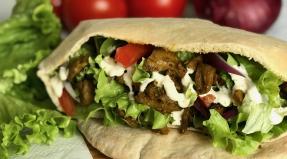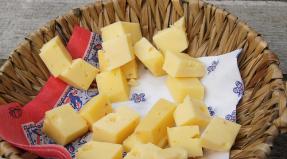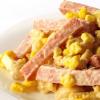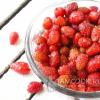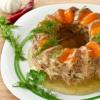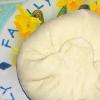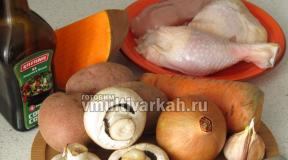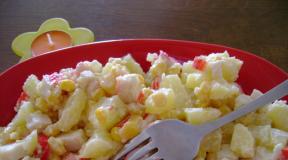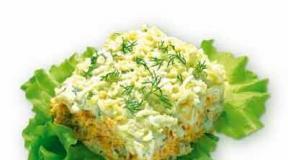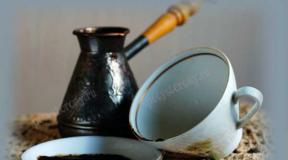Make soda at home recipe. How to make soda at home at no extra cost? Drink with sourness
Carbonated water (soda) or soda has been known to mankind since the end of the 19th century. It used to be sold in special vending machines, but soon appeared on store shelves. Today, residents of developed countries cannot imagine life without this drink, and producers of carbonated drinks successfully use it by raising the price of their product. Therefore, we will tell you how to make sparkling water at home and save your money.
Making homemade sparkling water is a simple and fairly quick process. All methods are based on the addition of carbon dioxide, which has neither taste nor smell. This gas dissolves easily in water, making it taste sour.
Using special siphons
To prepare carbonated water, the easiest way is to use a special cylinder or siphon with ready-made carbon dioxide. They are sold at any hardware store. You can also place an order online.
Use the device for carbonating water at home as follows:
- Pour chilled water into the siphon.
- Screw on the carbon dioxide bottle.
- Unscrew the valve and wait a few seconds for the carbon dioxide to pass into the siphon.
- Turn the bottle around and close the siphon to prevent gas from escaping.
Pouring soda from a siphon into glasses is very convenient. To do this, you just need to press the lever until a sufficient amount of drink is poured. If we compare the cost of purchased and home-made sparkling water, the latter will be more beneficial for the consumer.
Cooking with improvised means
There are also many ways to carbonate water at home without using a siphon. All the necessary components can be found in the kitchen of any hostess.
First way:
- Place a teaspoon of baking soda in a glass.
- Add to it 2 teaspoons of squeezed lemon juice or half a spoon of citric acid.
- Pour everything with clean chilled water and stir. Soda is ready!
Using these ingredients, you can also prepare large portions of soda. Plastic bottles or other tightly closed containers are acceptable as a vessel.
To improve the taste of the drink, you can add powdered sugar, syrup, honey and other natural additives. And its basis instead of water can be any juices and fruit drinks.
The second method differs from the previous one by using vinegar instead of lemon juice. For cooking you will need:
- 1 liter of clean chilled water;
- 7 tablespoons of 9% vinegar;
- 2 teaspoons of baking soda;
- meter tube;
- 2 dark plastic bottles;
- 2 caps with holes smaller than the tube diameter.
Cooking method:
- Attach the ends of the tube to the two caps.
- Fill one bottle with cold water.
- Wrap the soda with a napkin and place it on the bottom of the second bottle.
- Sprinkle the napkin with the vinegar solution.
- Close bottles tightly with caps to prevent carbon dioxide from escaping.
- Shake the bottle for 5-6 minutes until the outgassing reaction is complete.
- When the water is saturated with gas, close it with a simple lid and place it in the refrigerator.
This is a very cheap way to get soda. But such water is not recommended to be used often, as it contains residues of vinegar and bicarbonate acid, which, at high dosage, irritate the mucous membranes.
You can make carbonated water at home using fermentation. To do this, prepare the following ingredients:
- 4 liters of drinking water;
- 1 glass of warm water;
- ½ cup sugar;
- bread yeast - 1 tablespoon or beer yeast - at the tip of a teaspoon;
- food additives and flavorings to taste.
Cooking method:
- Pour the yeast with warm water and leave for 5-10 minutes until completely dissolved.
- Transfer the yeast to a container and mix with sugar and food additives (if any).
- Slowly pour cold water into the container, stirring constantly. Make sure all ingredients are well mixed.
- Pour the prepared solution into plastic bottles and close them.
- Leave the mixture in a dark place until the end of fermentation (about 5 days), unscrewing the lids from time to time.
- After the end of fermentation, the bottles should be stored in the refrigerator.
The fourth way is to use dry ice. It is not so easy to get it, but if you succeed, you need to use it right away, since it is stored only at a very low temperature. To carbonate, fill a liter jar with water, add a small piece of dry ice there, wait a few seconds - and the drink is ready!
Carbonated water at home is not only cheaper, but also much more useful than store-bought. In addition, you can add various additives and syrups to it, getting new delicious drinks for the whole family.
how to make soda: Video
1. Without using a siphon
w-dog.netYou will need:
- 2 teaspoons of soda;
- 2 teaspoons of citric acid;
- 1 glass of water;
- sugar - to taste;
- syrup.
Mix citric acid and pour over with a mixture of water, sugar and syrup, add ice and drink as quickly as possible. Citric acid will react with soda, bubbles will appear. If the taste seems too strong, reduce the amount of soda and citric acid.
Of course, such lemonade will not be carbonated for long, but as a fun experiment, you can try it. Plus, it's fast and inexpensive.
2. Using a homemade siphon

You will need:
- 2 plastic bottles;
- awl;
- 2 stoppers;
- a small hose or flexible tube;
- a spoon;
- funnel
- 1 cup of vinegar;
- 1 cup baking soda;
- any liquid.
Make holes in two covers, tightly fix the hose in them. Calculate so that one end of the hose almost touches the bottom of the bottle. Pour the liquid you want to carbonate into one of the bottles and close it tightly. The hose should go as deep as possible into your future lemonade.
Pour soda into the second bottle through a funnel, fill it with vinegar and quickly close the second cap. If you hear a hiss and see the mixture bubbling, you've done it right. If the vinegar and baking soda don't react strongly enough, shake the bottle. This will enhance the response.
The gas will go through the hose, saturating the lemonade with carbon dioxide. If the connection is leaky, you will get a slightly carbonated drink.
You can carbonate any water-based drink, but it's best not to experiment with coffee and tea. On average, a liter bottle of water can be carbonated in 15–20 minutes. Of course, the process of creating a siphon will take time, but it will not be wasted.
3. Using a purchased siphon
 geology.com
geology.com The siphon can be ordered online or searched in stores. Now there is a large selection of plastic and metal soda siphons, even with drawings. So finding one that fits into will be easy.
The principle of operation of a purchased siphon is the same as that of a home-made one, only compressed gas cartridges must be purchased separately. And if you find a vintage siphon, it will not only help to carbonate water, but also serve as a stylish piece of furniture.
How to make homemade lemonade
ginger lemonade
 epicurious.com
epicurious.com This lemonade is more popular in Asia than here, but for lovers of everything unusual, it can become a favorite drink.
Ingredients
- 1 liter of sparkling water;
- a small piece of ginger root;
- sugar - to taste;
- zest of ½ lemon.
Cooking
Remove skin and finely chop. Mix with the rest of the ingredients, pour boiling water and let cool.
You can prepare ginger syrup in advance and dilute it with water. To do this, grate fresh ginger on a fine grater and add to sugar syrup.
cucumber lemonade
 skinnyms.com
skinnyms.com This light lemonade with a mild taste perfectly quenches thirst. And cucumber water is the basis of many cleansing diets.
Ingredients
- 1 liter of sparkling water;
- 1 large cucumber;
- juice of ½ lime;
- 1 teaspoon honey.
Cooking
Cut the cucumber into thin slices and cover with water, let it brew for about 30 minutes. Then add honey, lime juice and sparkling water. Berries can be added before serving. They will pleasantly shade the taste of the drink.
Lemonade with cinnamon and grapefruit
 getinmymouf.com
getinmymouf.com Grapefruit charge of morning energy for those who love non-standard combinations.
Ingredients
- 1 liter of sparkling water;
- 3 cinnamon sticks;
- juice of 1 grapefruit;
- juice of ½ lemon.
Cooking
Mix juices, soak cinnamon sticks in them for 30 minutes. Then take out the cinnamon, dilute the juice mixture with carbonated water. Before serving, return the cinnamon to the lemonade for garnish.
As you know, people began to carbonate water for a long time. Now it is customary to do it on a production scale. But in order to try to process the water yourself, you need to carefully understand all the intricacies of the process.
Good reasons
Hippocrates also wrote about the benefits of water with gases. He talked about its positive and even healing effects on the body. Then no one tried to carbonate water. People used the gifts of nature. They collected life-giving moisture with bubbles in bottles and carried it to where there were no such sources. Everything would have been fine, but over time, the water ran out of steam on the way, and it turned out to be extremely unpleasant to use it in this form. Since then, many have begun to think about how to re-carbonate water so that natural processes do not affect this factor. Scientists have found that there are two different ways of gassing a liquid: mechanical and chemical. The first is the direct saturation of the liquid fraction (ordinary fruit, mineral water or wine) with carbon dioxide. And the second involves the appearance of the same bubbles as a result of chemical reactions: fermentation (beer, kvass, cider and champagne) or neutralization (soda water). Each of them is interesting in some way and has found its place in a person's life.
unstoppable bubbles
The English chemist Joseph Priestley was the first to learn how to carbonate water. In 1767 he observed this phenomenon during the fermentation of beer in vats. A little later, the Swede Bergman invented his "saturator", which, using a pump, saturated the water with carbon dioxide. But mankind was haunted by the idea of industrial production of "boiling water". Using previous experience, in 1783 Jacob Schwepp designed a special plant and was the first to put the new production on an industrial footing. A little later, he began to use baking soda as an initial component and became the progenitor of the future popular drink. Over time, he created an entire company and registered the Schweppes trademark. Often people ask the question: "Why do you need to treat water like this?" There are several reasons for this:
1) Carbonation neutralizes unpleasant odors and improves the taste of ordinary water. It is known that, for example, mineral water smells bad if you drink it warm and without bubbles.
2) In warm weather, water treated in this way better quenches thirst.
3) Carbon dioxide, which is saturated with liquid, is an excellent preservative and allows you to keep any drink for a long time.
All this causes even greater interest in the problem on the part of not only ordinary people, but also owners of large industries.
Beginner Option

Sometimes you want to drink so much, but there is no desire to go to the store. The question arises as to what to do in this case. How to make sparkling water without leaving home? The easiest way is suitable even for a child. You will need very little:
- free capacity (an empty bottle or a simple glass),
- baking soda,
- sugar,
- lemon acid,
- ordinary water.
In order to make a drink, you need:
- Take some baking soda, pour a lemon on it (or squeeze a few drops from a slice of lemon) and wait a bit. As a result, the process of quenching will occur.
- Now you need to mix all the ingredients. To do this, pour water into a glass, add a spoonful of granulated sugar and stir it quickly. Then add ½ teaspoon of lemon and slaked soda prepared before. It remains only to mix everything well.
This is the easiest option, remembering which, each person will be able to understand how to make sparkling water. This method was used quite often in Soviet times.
Precautionary measures

People are always interested in details. But before you figure out how water is carbonated, you need to decide for yourself whether it is worth drinking such drinks at all. After all, liquids of this kind are not useful for everyone. There are categories of people for whom they are completely contraindicated. This:
1) Small children under three years of age, whose digestive system is not yet accustomed to such exposure.
2) People suffering from various disorders in the work of the gastrointestinal tract. This includes those who have doctors found an ulcer, gastritis, hepatitis, pancreatitis and other diseases. In them, carbon dioxide, getting inside, causes a sharp irritation of the mucous membrane and exacerbates the already existing inflammatory processes.
3) A person prone to allergies or overweight. This category of people should also refrain from drinking "dangerous" liquids.
Everyone else should think carefully before throwing their eyes at the bright labels in retail outlets or understanding technological processes.
Familiar Devices

In order to get a pleasant soft drink, it is not necessary to go to the store and stand in line. For this purpose, a special apparatus has long been invented. This is a siphon that carbonates water. It is small, used at home, and large, which is often used in bars and cafes. In the Soviet Union, you could see machine guns everywhere on the streets, which, after pressing a button, filled faceted glasses with a stream of life-giving moisture. These devices are now gone. There are only models intended for home use. They are very simple. The siphon consists of a container with a lever and a cylinder of carbon dioxide. The operation of the device is based on the laws of physics and chemistry. The main vessel is three-quarters full of water. A cylinder is attached to it, which fills the remaining space with carbon dioxide through the inlet valve. And after pressing the lever, the liquid under pressure comes out. As a result, ordinary carbonated water appears in the glass. With the help of special syrups and flavorings, you can give it the desired taste or make your favorite cocktail.
For every taste

Everyone can choose for himself the water siphon that he likes best. Many years have passed since the creation of the first devices. During this time, specialists have developed devices of various modifications. The most famous of them:
1) Siphons of the Austrian company Isi and the Italian company Paderno. They are similar to those that were produced 40-50 years ago. The only difference is that the case is made of stainless steel instead of ordinary glass. They keep the temperature of the water for a long time and are quite inexpensive. But these siphons have a major drawback - danger. The gas cartridge is inserted manually, which, if used ineptly, can result in serious injury.
2) SodaTronic type device. It has no water. This device is intended for carbonation of ready drinks. The design contains a replaceable gas container, which allows you to adjust the degree of saturation of the product with carbon dioxide.
3) Devices "SodaStream". In them, water is poured into a special bottle, which is already included in the kit.
The choice of device in any case always depends on the desire of the buyer.
Once upon a time the grass was greener and the sun brighter. And carbonated water in our Soviet childhood is much better and tastier than it is now. And no wonder. In the Soviet Union, natural products, herbs, and lemons were used for lemonade.
And these drinks could be stored not for several years, but only for a few days.
I offer you five recipes for refreshing lemonades, which every child drank in Soviet times.
You can make these drinks yourself.Summer will come soon, the heat will come! Pamper their relatives and friendsdelicious natural and healthy drinks. How many grateful words you will hear!
Those lucky ones who have a siphon can carbonate water with it. And for those who do not have a siphon, I suggest using store-bought sparkling and highly carbonated water, since there are a lot of them on sale now.
So, back to the USSR!
Citro(5-6 servings)

(Perhaps the oldest soft carbonated drink. In Soviet times -a proper name for one of the produced types of lemonade. Now often used by many people as a common noun for all types of carbonated drinks. Soviet "Sitro" was created decades ago by selecting combinations of citric acid, sugar, flavorings and syrups of various citrus fruits. So, the aromatic basis of the Citro-Extra drink was infusions of orange, tangerine, lemon with the addition of vanillin.)
4 lemons;
1 cup of sugar;
5 glasses of water (through a siphon) or 1 liter of store-bought highly carbonated water.
Grate the zest of 1 lemon. Squeeze the juice from this lemon and three more.
Put everything in an enamel pan, add sugar. Pour water.
Boil for 10 minutes, remove from heat, strain and cool.
Pass through a siphon (optional).
Serve with lemon slices and ice.
Duchess(4 servings)

(Pear carbonated drink "Duchess" perfectly replaced sweets and cakes for Soviet children. Pear infusion was added to the usual lemonade base, lemons, sugar and carbon dioxide bubbles completed the picture. This soda was loved by both children and adults. After all, fragrant, sweet pear lemonade "Duchess" perfectly quenched thirst.)
4 pears;
2 lemons;
8 tsp Sahara;
800 ml soda or just sparkling water.
Squeeze juice from pear and lemon, then mix. Add sugar diluted with a little water.
Add sparkling water, mix and let it brew a little.
Pinocchio(20 servings)

(The most famous Soviet soda. The childhood of almost every person born in the Soviet Union is associated with Pinocchio. It was prepared very simply: water, sugar, lemons and oranges. It's all natural, which is probably why it tastes so good.
The bottle had a label with the image of Pinocchio, and the cost of the drink was 10 kopecks "without the cost of dishes", as they liked to write on Soviet bottles.)
2 lemons;
2 oranges;
2 liters of water;
2 liters of soda;
½ cup sugar.
Squeeze juice from lemons and oranges. Strain it.
Put sugar in a small bowl, moisten it with a few tablespoons of water, stir, put on fire and bring to a boil.
Cook over low heat until the sugar turns light brown.
Add juice and water to sugar. Stir.
Pour halfway into glasses filled with ice. Top off the other half with soda.
You can pass through the siphon. Then add another 2 liters of water to the lemonade. And gas everything in the siphon.
tarragon(10 servings)

(The Tarragon recipe appeared in the 19th century. It was invented by the pharmacist Mitrofan Lagidze, who lived in Tiflis (modern Tbilisi). He was the first to think of adding the extract of the famous Caucasian plant tarragon (tarragon) to sweetened carbonated water.
In mass production, the drink appeared in 1981. And since 1983, "Tarhun" began to be produced and sold in many republics of the former USSR. They made a drink from water, citric acid, sugar and tarragon extract.)
1 bunch of fresh tarragon;
2 lemons;
2 limes;
1 cup of sugar;
1.5 liters of sparkling water;
1 glass of plain water.
Remove the tarragon leaves from the stems.
Pretty easy way to get soda at home. Based on the simple dissolution of CO2 in water. To do this, we will build a CO2 generator. Its work is as follows: when vinegar interacts with soda, CO2 is released, then it passes into the second vessel and there it dissolves in our carbonated liquid. Just isn't it?
We will need: vinegar, soda, a couple of plastic bottles, a tube, a piece of napkin or toilet paper.
Here is what we did:
As can be seen from the figure, two bottles are securely connected by a tube. Please note that in the second bottle where our carbonated liquid will be poured, the tube goes to the very bottom, and in the first bottle where the reaction will take place, the tube peeks out a little from under the cap.
We pour 100-150 ml into the first bottle. vinegar, in our second liquid, which we will carbonate. Close the second bottle tightly.

Then we turn in our toilet paper st. a spoonful of baking soda. This is done in order to pour soda at once and not lose CO2.

We throw and quickly close.

The reaction begins! For better absorption of CO2 liquid, it must be shaken, and also, to increase the reaction, shake a bottle of soda and vinegar. In short, it is better to shake both bottles alternately.

After a while, the reaction will end and you will get a soda made by yourself!

One of the Western firms even sells this device.

